

Virtual tour of OSU dairy farm
No two dairy farms are the same, but the general methods of conventional milk production are comparable across the U.S. and western Europe. Although all dairy cows are slaughtered for beef at some point in their lives, dairy cattle are bred almost exclusively for high milk production, meaning a farm relying mostly on milk sales will use different breeds than those relying on sales of beef. Most all dairy cows are fed a high-energy diet of grains and legumes, in addition to forage (grass and hay), and are milked 2-3 times each day in a parlor using automatic milking machines. It only takes about ten minutes to milk a single cow using the automatic milkers. For those unfamiliar with dairy production, this lecture will take them on a virtual tour of the dairy farm at Oklahoma State University, which is a decent representation of most dairy farms in the U.S.
On this tour we will start with a recently born calf and discuss how its life changes as it ages, allowing us to learn how dairy cows are fed, housed, bred, and milked.
Birth
Figure 1—A heifer is born
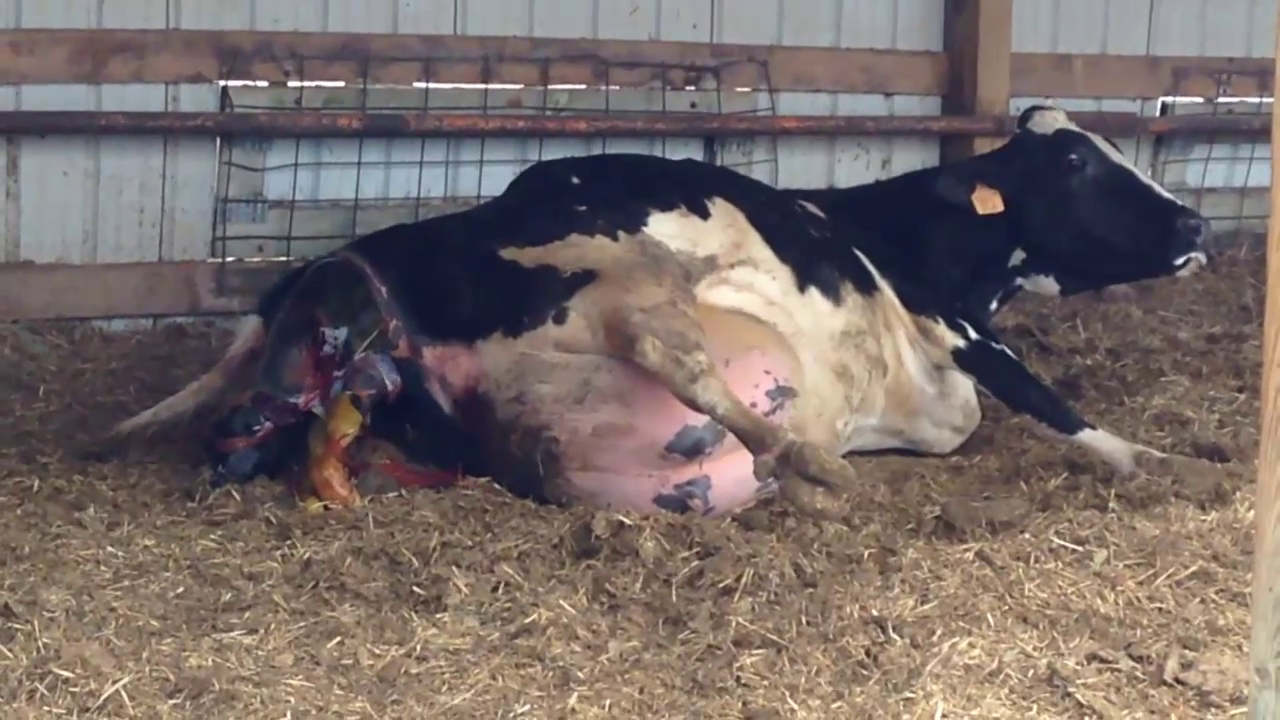
Figure 2—Taken from its mother

When a cow is giving birth the farm workers will leave her alone unless it looks like the health of the cow or calf is in jeopardy. Once born, the mother is allowed a short time alone with her calf, which she will use to clean the calf with her tongue and eat the placenta. Just as the calf becomes dry and able to walk, it is separated from its mother, never to reunite until the calf is much older. The reason for this separation mainly has to do with ensuring good nutrition for the calf. The mother will look a little concerned as her calf is taken away, but I’ve never actually seen one try to defend her calf or even call out very long for her offspring.
When a mammal gives birth, its milk will initially contain high levels of colostrum, a fluid containing antibodies that help boost the calves’ immune system. It is imperative that the calf receive quality colostrum in its first few days. The quality of the colostrum varies across cattle, so rather than hoping the mother has good colostrum, the calf is separated and fed colostrum from another cow whose colostrum level has been tested and proven to be high in antibodies. The mother is milked by humans and her colostrum tested for antibodies. If the colostrum is of high quality it will be frozen so that it can be fed to other calves in the future.
Figure 3—The heifer’s first taste of [formula] milk
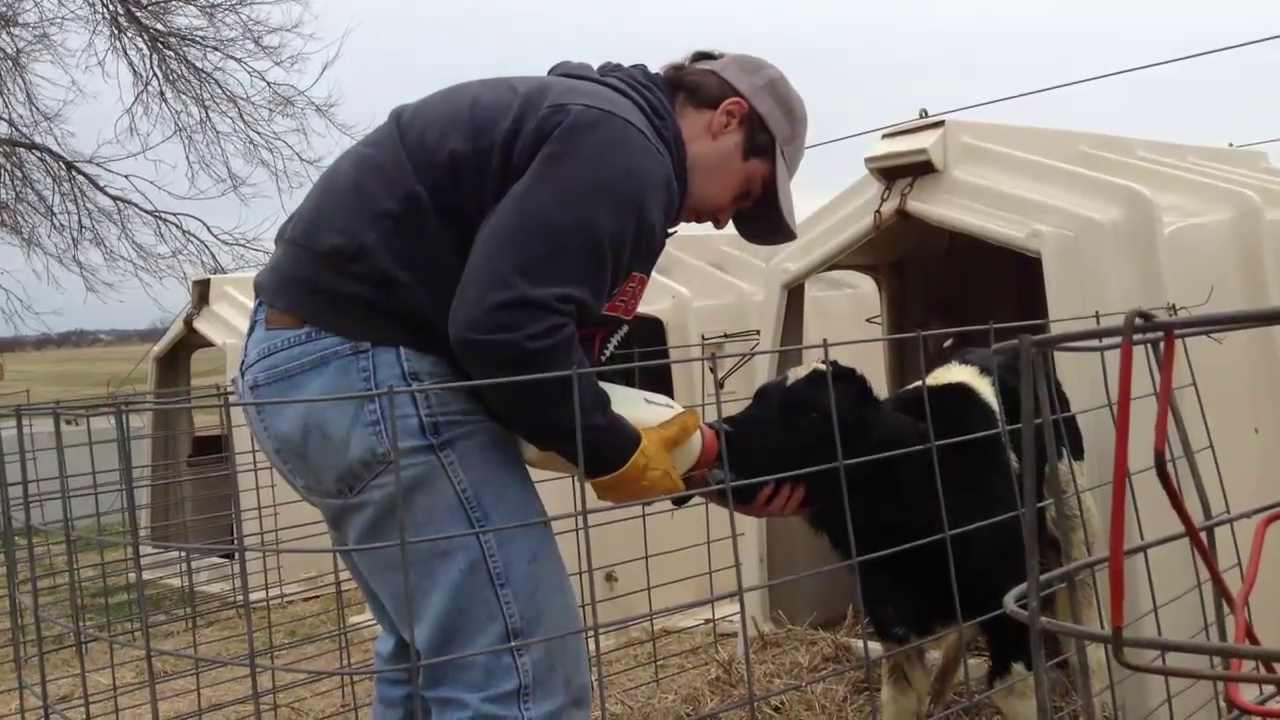
The calves remain separated from their mothers because the mother’s milk is reserved for human consumption. Don’t worry, the calf will receive plenty of nourishment from a milk made from formula, much like the formula milk my mother fed me (as breastfeeding was not popular in 1974). This formula milk is even fed from a bottle for the first week of its life, and from a bucket thereafter, until weaning. The formula milk fed to the calf will be made from ingredients like cow milk, blood cells, wheat, and soy. As the calf ages the formula milk will be supplemented with grain and hay, and at weaning it will no longer receive the milk formula. The amount and type of feed is scientifically designed to meet the calf's precise nutrition requirements, given its breed and age. Trust me, if you give just half the thought to what you feed your child as dairy farmers do for their calves, your children will be healthy and strong!
From birth till weaning
You’ll notice the calf has its own little housing unit, separate from other calves. Calves are vulnerable to disease at this age, and keeping them separated from other calves reduces the spread of sickness. This also makes it easier to monitor exactly how much each calf is eating to ensure the calf is healthy. Because they do not nurse from their mothers the calves are confused about where milk comes from. Walk up to any dairy calf and extend your hand and it will try to nurse from it (really, you can do this, it doesn’t hurt). If you place the calf in a group with others they will try to nurse from one another, also. Of course, they won’t find any milk, and this frustrates them, so they tend to butt the udders of their peers, causing injury and perhaps even knocking each other down. In general, whenever you see livestock producers separate animals into individual pens, whether it be cows, pigs, or chickens, it is usually to prevent them from hurting one another.
Figure 4—Dinner time!
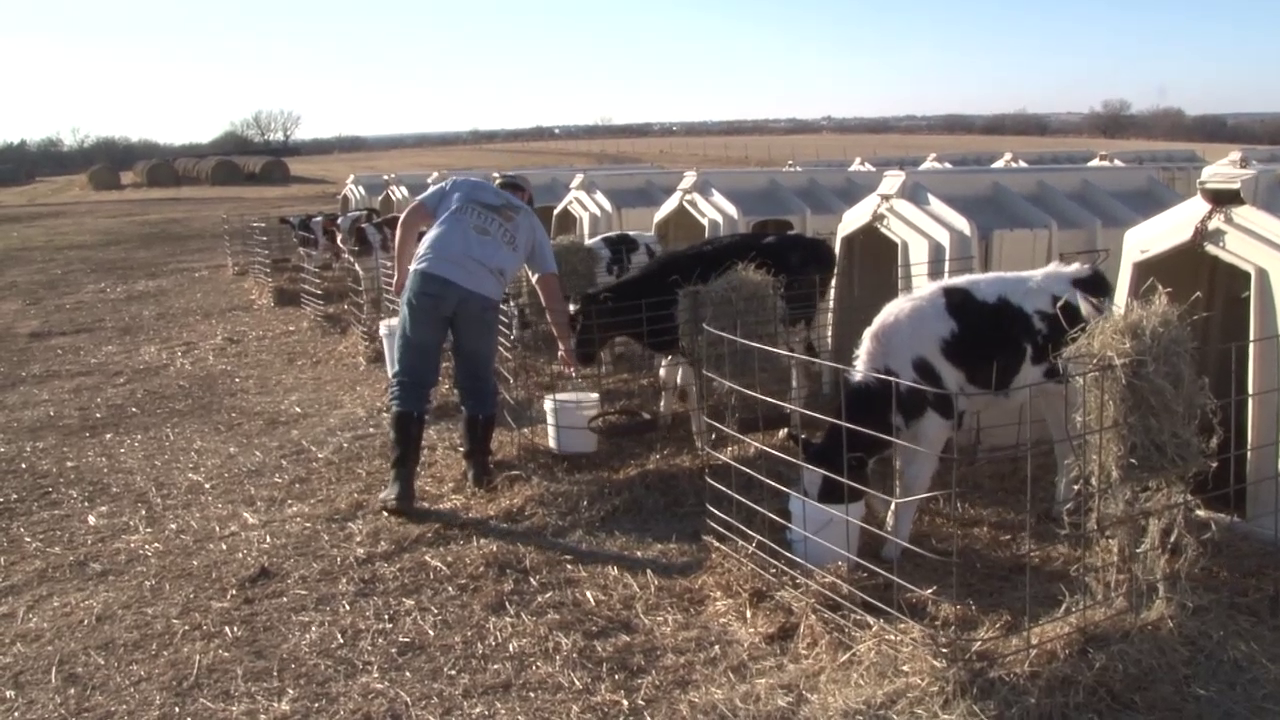
When born, the calves will be fed only formula milk twice a day (3:00 AM and 3:00 PM), and after three weeks grain and forage will be added to the diet. At eight weeks of age they will receive formula milk only once a day, and when they turn nine weeks old they are weaned completely. Shortly after weaning they can be placed in groups with other calves and consume only grain and forage.
If you look closely on the heads of most breeds of dairy calves you will find the beginning of horns. Yet, in all the Chick-fil-A commercials you’ve seen the black and white cows (Holsteins, they are called) don’t have horns. What gives? To keep the cows from hurting farmers and each other their horns are removed at an early age.
If you feel around the top of the calves’s heads you can find the roots of budding horns. By burning these roots with an electric dehorning iron, or by rubbing them with a special paste, these roots can be removed and horns will not grow. It is painful, for sure, but if performed at an early age the pain is only temporary is less painful than being stabbed in the side by another cows’s horns. These calves have the fortune of being part of university research involving animal scientists and veterinarians in how to minimize the pain from dehorning, so not only will they feel less pain than other calves, but are helping us learn how to improve welfare throughout all dairy and beef cattle production.
The females, called heifers, will stay here on the farm for milk production. After weaning at about nine weeks of age the heifers will be placed into small groups of similar-aged calves and fed a high-energy, high-nutrient diet, supplemented by all the forage they wish to eat.
You’ll notice that every cow we will see, from the calf to her milking mother, is provided shelter with dry bedding for their comfort.
From weaning to first breeding
At nine weeks of age the calves are ready to be weaned but not quite ready to enter a pasture, so for the next three weeks they are kept in a small pen with a few other recently-weaned calves. For the first time in her life, a heifer is not in a social setting. Here she is fed forage and grain and provided shelter with comfortable bedding. Heifers used to receive low doses of antibiotics / antimicrobials in their feed at this stage, and some still do, but its use is declining as dairy farmers respond to concerns about overuse of antibiotics. On this dairy farm cattle are only given antibiotics if they are sick, and if they are providing milk at this time their milk is not used for human consumption.
At twelve weeks of age a heifer is ready to enter pastures with other cattle, living a tranquil life and rarely handled by humans until she is 15 months of age, when she will be bred for the first time.
Figure 5—Weaned onto hay and grain
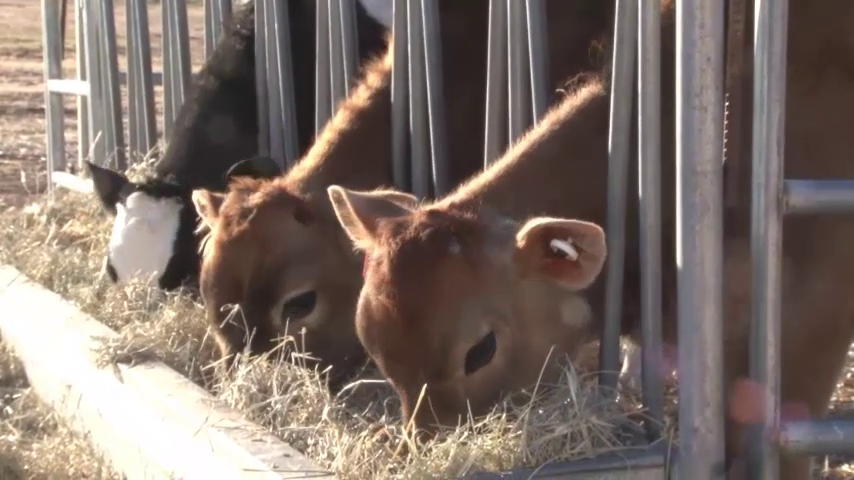
Figure 6—Between weaning and first breeding
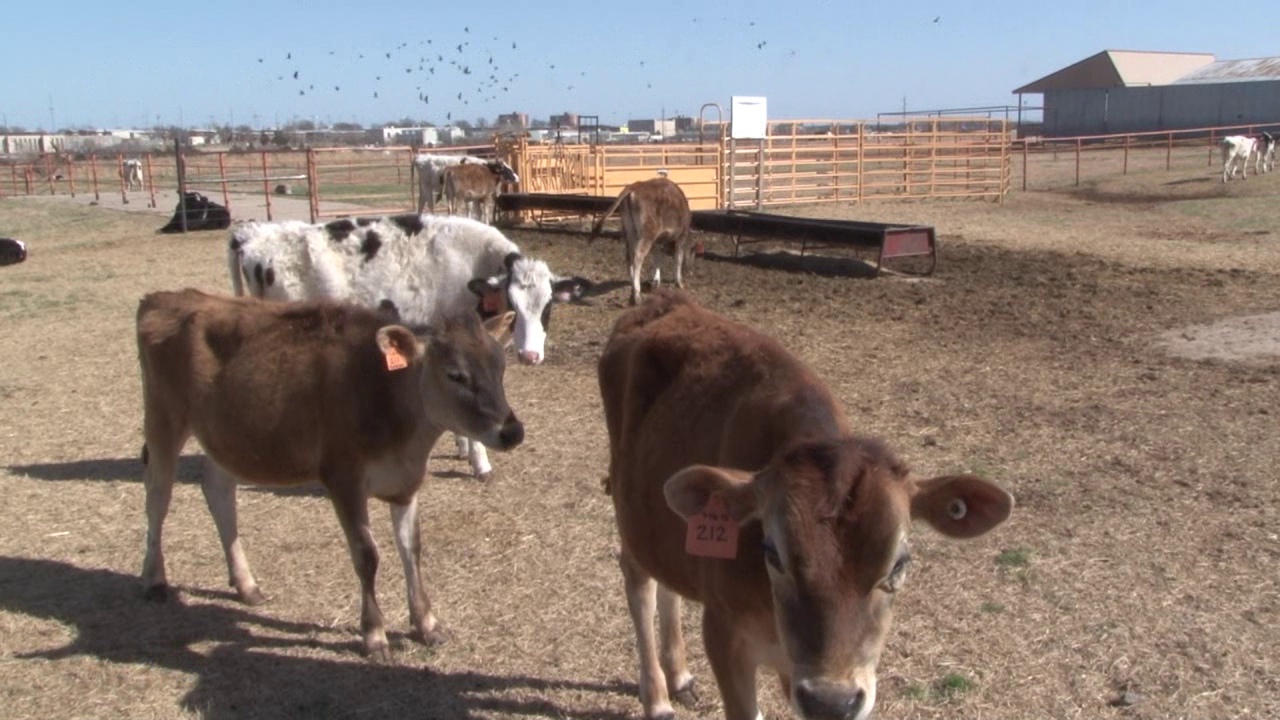
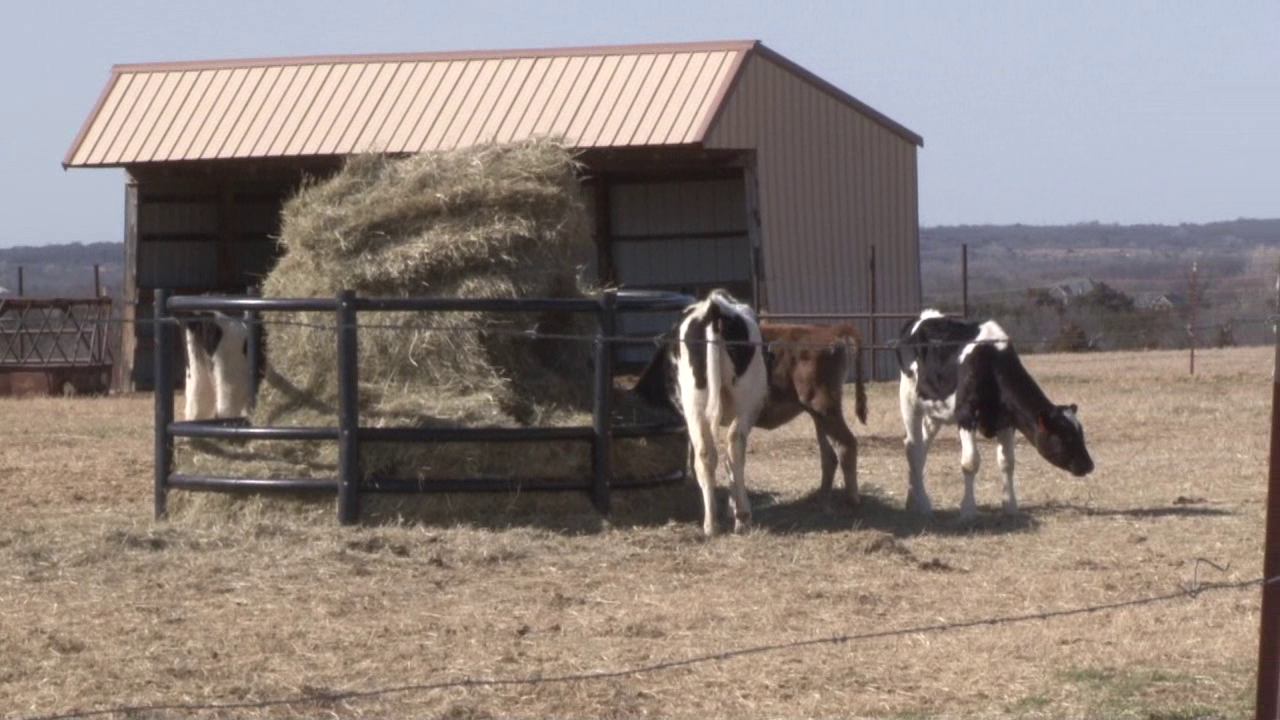
Artificial insemination at 15 months of age
Now the heifer is ready to be bred, but you won’t find a bull on this farm. Instead, she will be bred using artificial insemination. For those interested in how artificial insemination works, please see the following video created by the agricultural college here by Dr. Stein at the Department of Animal Science at Oklahoma State University.
To artificially inseminate a cow, you first thaw bull semen and place it in a metal rod referred to as a “straw”. This rod will be inserted into the cows vagina and through the cervix, where the semen is then deposited. To manipuate the straw through the cervix you must first place a long glove on one arm and insert this arm into the cow’s rectum, with the straw held in the other hand. Through the rectum wall you locate the cervix and grasp it in your hand. Then, you push the cervix away from you so that the tunnel between the vagina and the cervix is straightened, after which you insert the straw into the vagina, through this tunnel, and then through the cervix. Once the straw is on the other side of the cervix you then eject the semen.
Of course, you only artificially inseminate the heifer when she is in estrus.
Figure 7—Artificially insemination
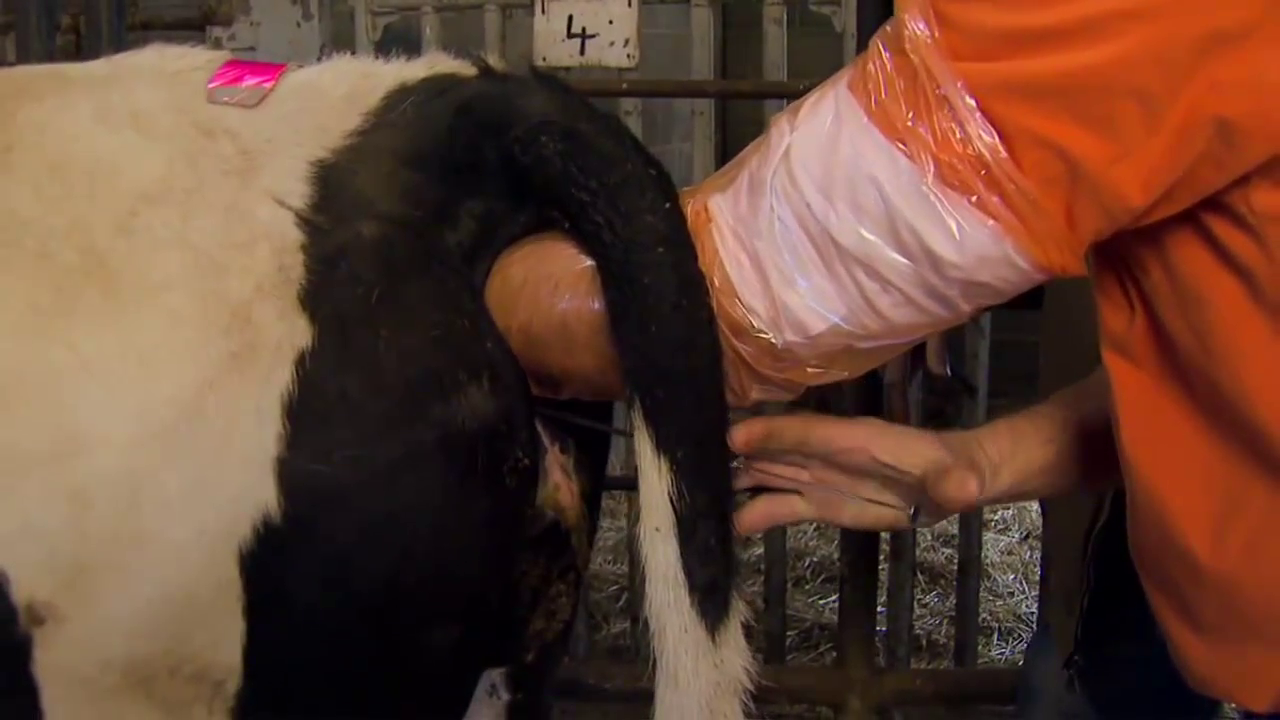
Two years of age
Gestation (the time between conception and birth) for a cow is about nine months, so if she is bred at fifteen months she will give birth when she is two years old. During gestation dairy farmers will keep heifers in an outdoor lot, barn, or pasture. Wherever they are located they will be provide ample space, shelter, comfortable resting areas, and superb nutrition. This farm provides pregnant heifers with pasture and shelter.
At two years of age, the heifer is ready to give birth for the first time. Her calf will be removed immediately after birth and for the first three days after birth her milk will be kept from the milk supply because it is high in colostrum. Once she has ceased producing colostrum her milk will be used for human consumption.
Twice, sometimes three, times a day she will be taken to a milking parlor. This is probably a pleasant experience. It give her exercise, variability in her activities, and relieves pressure in her udder, which can become uncomfortable if not milked.
Figure 8—Cow’s view of milking parlor
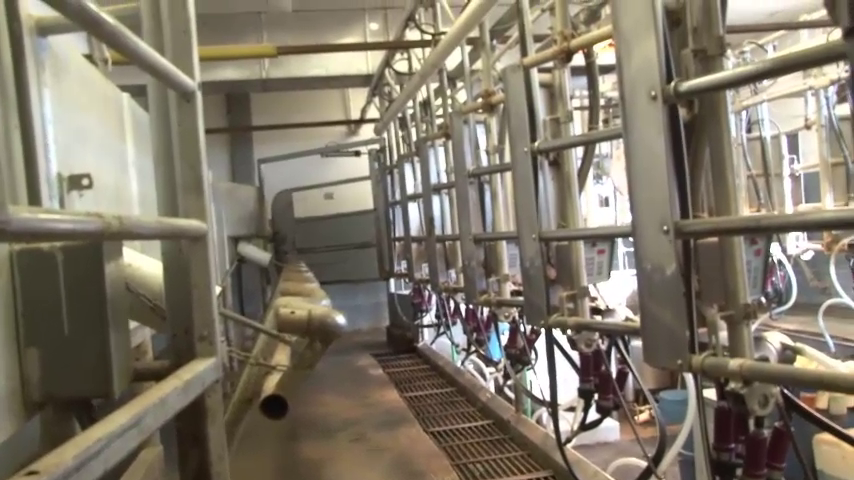
The milking parlor
All modern dairy farms use automatic milkers, where the udders are cleaned and the milkers are placed on the udders by humans, but a machine does all the sucking, delivering all the milk into a storage tank. Observe what the milkers do for each cow. First they clean the udder, and then they dip it in hydrogen peroxide, to help sanitize it. They will visually inspect milk from the udder to make sure the milk looks healthy, after which they will attach the automatic milkers and move to the next cow. About ten minutes later the machine will automatically detach itself from the udder and the workers will dip the teat in iodine, for sanitation, before they release the cow.
Figure 9—Attaching the automatic milker to the cow’s udder
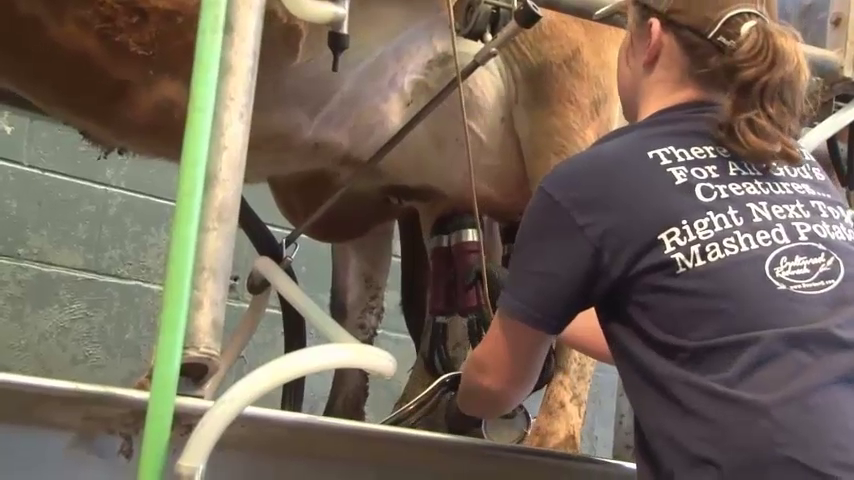
While this is a typical parlor design, other designs exist. There even now exists a system where animals are led into a stall and milked automatically, with no human labor at all. Search the term “robots in agriculture” at criticalcommons.org to see a video of such a machine.
When the milkers squeeze each teat to inspect the milk they are looking for a bacterial infection called mastitis, where the mammary glands are inflamed, causing the cow pain and clumpy, semi-solid milk.
Figure 10—Checking for mastitis
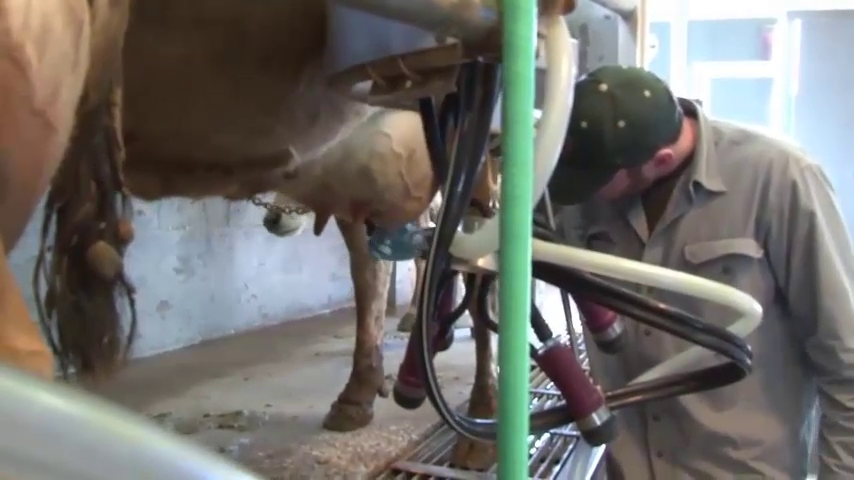
The rest of a cow’s life
While the cow is producing milk she will be kept in a lot close to the milking parlor. She will be provided shelter with comfortable bedding (on this farm, sand), generous portions of food, and sometimes outdoor access with pasture.
Figure 11—Resting areas
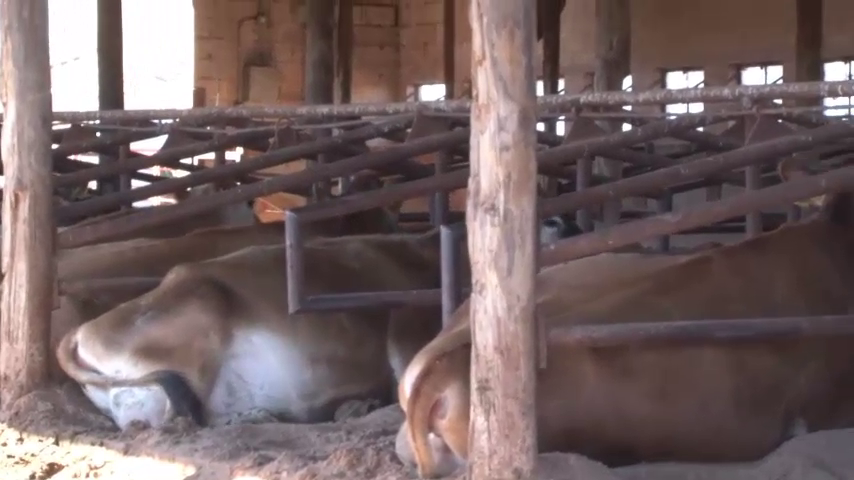
Remember that the cow is about 2 years old the first time she is milked, and 2 months after that she will be bred for a second time.
Then when the cow is 2 years and 9 months old she will be removed from the milking heard and sent to a “dry lot” where she will have access to pasture (during the growing season), other food, shelter, and the like. After two months in the dry lot, when she is 2 years and 11 months old, she will be ready to give birth again, and then return to the milking herd.
Figure 12—Dry cows, grazing
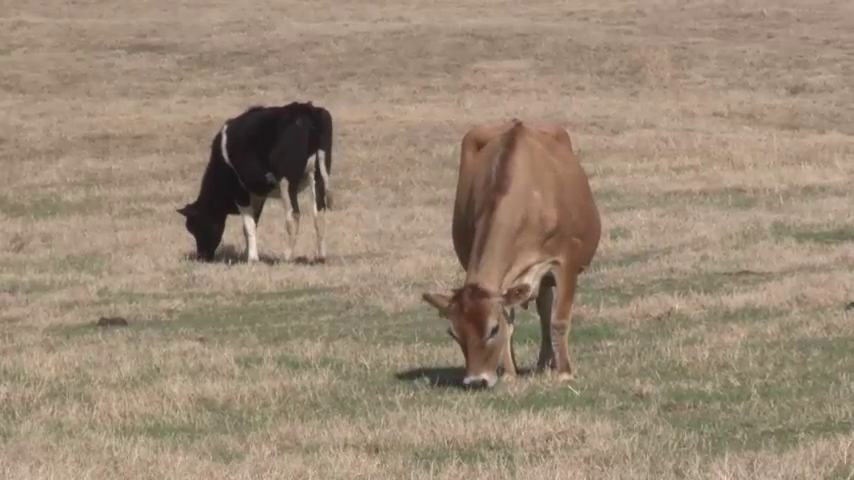
Once the cow has given birth about three times, and has been through the milking cycle three times, she will be “culled” from the herd and slaughtered for beef. It varies across cattle though, depending on how much milk the cow is producing and whether she conceives quickly. Cattle with low milk production numbers and experience difficulty conceiving will be removed from the herd earlier than other more productive cows.
What about the male calves?
The discussion thus far concerned only heifers retained by the farm for milking. What about the males, or the females that are not retained for milking? They will be sold when they are only a few days old, which is fairly typical for dairies. Dairy farmers wish to specialize in milk production, and there are other farmers who specialize in raising dairy cattle for meat. According to my sources, about 70% of male dairy calves will be raised for beef and 30% raised for veal (and by the way, veal is produced much differently than you probably think). Some farms now used sex semen, where the ratio of female to male calves born is higher than one-to-one.(N1)
Figure 13—Dr. Norwood feeding a calf
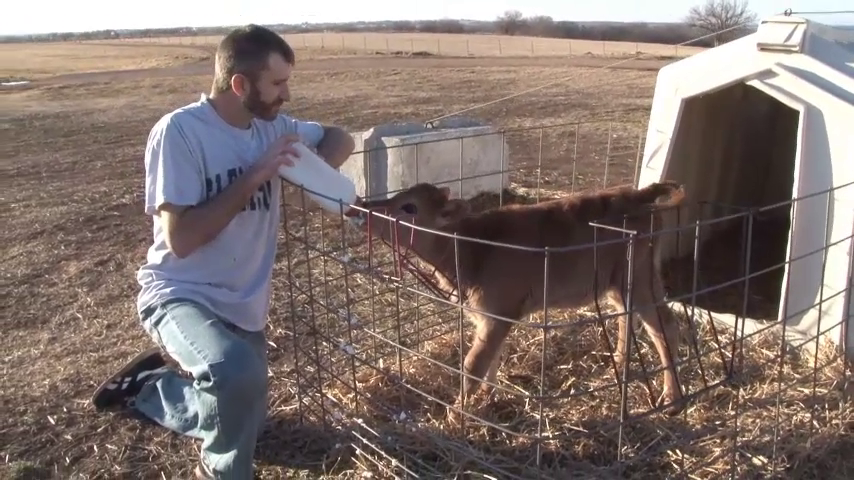
Figures
(1-6) Original photos
(7) Screenshot from Sunup video, accessed March 21, 2014 at http://www.youtube.com/watch?v=stvnGYcKz60&list=PLAF52949131FFB501
(8-13) Original photo